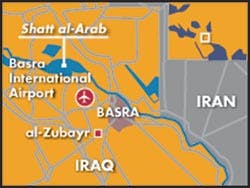We Came to Help
This was the Basra Team - with its Iraqi airport management counterparts. We came from diverse backgrounds, from airports and aviation-related businesses across America and beyond. Each came for his/her own reasons, but all were united by a common desire to make a difference in a country most of us knew very little about.
It was the latter half of 2003. An end to major hostilities had been announced and a disparate group of aviation pros was being assembled in order to get Iraq’s airports open to commercial traffic. Our team, led by former Olympia (WA) Airport director Doug Sandau, was tasked with breathing life back into the Basra Airport, located in Southern Iraq near the Kuwait border. It was a daunting challenge.
Working under the most austere conditions, we were tasked with bringing the airport back to life after decades of conflict, neglect, and international sanctions. Our initial reaction: Basra was in surprisingly better condition than expected.
While the airport had sustained some damage, much of it remained in relatively good condition. A 13,120-ft. concrete runway, taxiways, and ramp were in very good condition. The passenger terminal, exquisite in design with beautiful marble flooring and Middle Eastern architecture, seemed stuck in time, its old-style mechanical FIDS system announcing the arrival of flights from more than a decade ago. The passenger terminal was of two-level linear design — one end of the building for international, the other for domestic.
Years of neglect and sanctions had left the airport’s basic services in abysmal shape. Non-functioning water and sewage treatment facilities made living and working there more difficult. Airfield lighting vaults, along with many other critical systems, had been heavily cannibalized to keep them working due to a scarcity of spare parts.
Like a scene out of a Middle Eastern version of the TV show M*A*S*H, we lived and ate in temporary facilities. The heat was intense and the Iraqi insects relentless. The perpetually burning gas wells surrounding the airport made one pine for strict environmental protection regulations back home.
History
Basra is the largest city in southern Iraq, situated on the west bank of Shatt Al-Arab, 55 km from the Arabian Gulf and 545 km from Baghdad. Built by a German consortium of Straubag Bau AG, Bilfiger Berger and Universale in the 1980s, Basra Airport had been designed to accommodate three million passengers annually. But even in its heyday, the airport saw only a small fraction of that. Basra Airport encompasses approximately 2,300 hectares (5,687 acres) and is fully enclosed by a 27-km chain link security fence topped with three strands of barbed wire.
Long underutilized, Basra Airport suffered for years from inadequate funding, maintenance, and staff training. Virtually cut off from the rest of the world for well over a decade, the airport fell further and further behind in its compliance with international standards. No one from the airport staff had attended any form of training in over a decade. Basra had no aerodrome manual, no security program, and no master plan. There was no business plan, no marketing, concession, or air service development program in place.
Local airport directors, in addition to managing their airports under the most difficult circumstances, were also charged with overseeing air traffic control and meteorology departments. For much of the ‘90s, airport “management” at Basra consisted largely of trying to maintain critical systems with insufficient spare parts, watering the plants, and sweeping the floors. Problems at the local level were made worse by a lack of guidance from the top. Iraq’s civil aviation authority, the General Establishment for Civil Aviation (GECA), essentially ceased to exist after the 2003 war; Iraq’s membership in ICAO had lapsed years earlier. These were particularly difficult obstacles to overcome because Iraq’s civil aviation system had a very rigid, top-down structure. The GECA-approved local concession agreements controlled local staff hiring and salaries and exercised near complete control over airport development and budgets.
Due to woefully inadequate salaries, most of Basra Airport’s staff was forced to work second jobs in the years following the 1991 Gulf War.
What We Accomplished
Working closely with our Iraqi counterparts, the team set out to identify steps necessary to bring the facility back into operational condition. With the assistance of British forces and U.S. Army Corps of Engineers’ staff, we identified critical systems and prioritized repairs. Iraqi air traffic controllers and meteorologists were provided refresher training. We established security procedures and, in concert with British forces, created an access control badging office. While awaiting infrastructure improvements, we worked with Iraqi staff on fundamentals of airport management, including computer and English language skills and establishing a basic concession development program. We also worked with Iraqi airport management staff on ICAO compliance issues, best practices, and air service development.
By early 2004 the general security situation in Iraq had taken a decided turn for the worse. Attacks were increasing in both frequency and severity. By March, the Coalition Provisional Authority had decided to refocus the country’s commercial aviation development efforts on Baghdad alone. All of these challenges combined resulted in a corporate decision to withdraw from the project and leave Basra before we would have liked.
